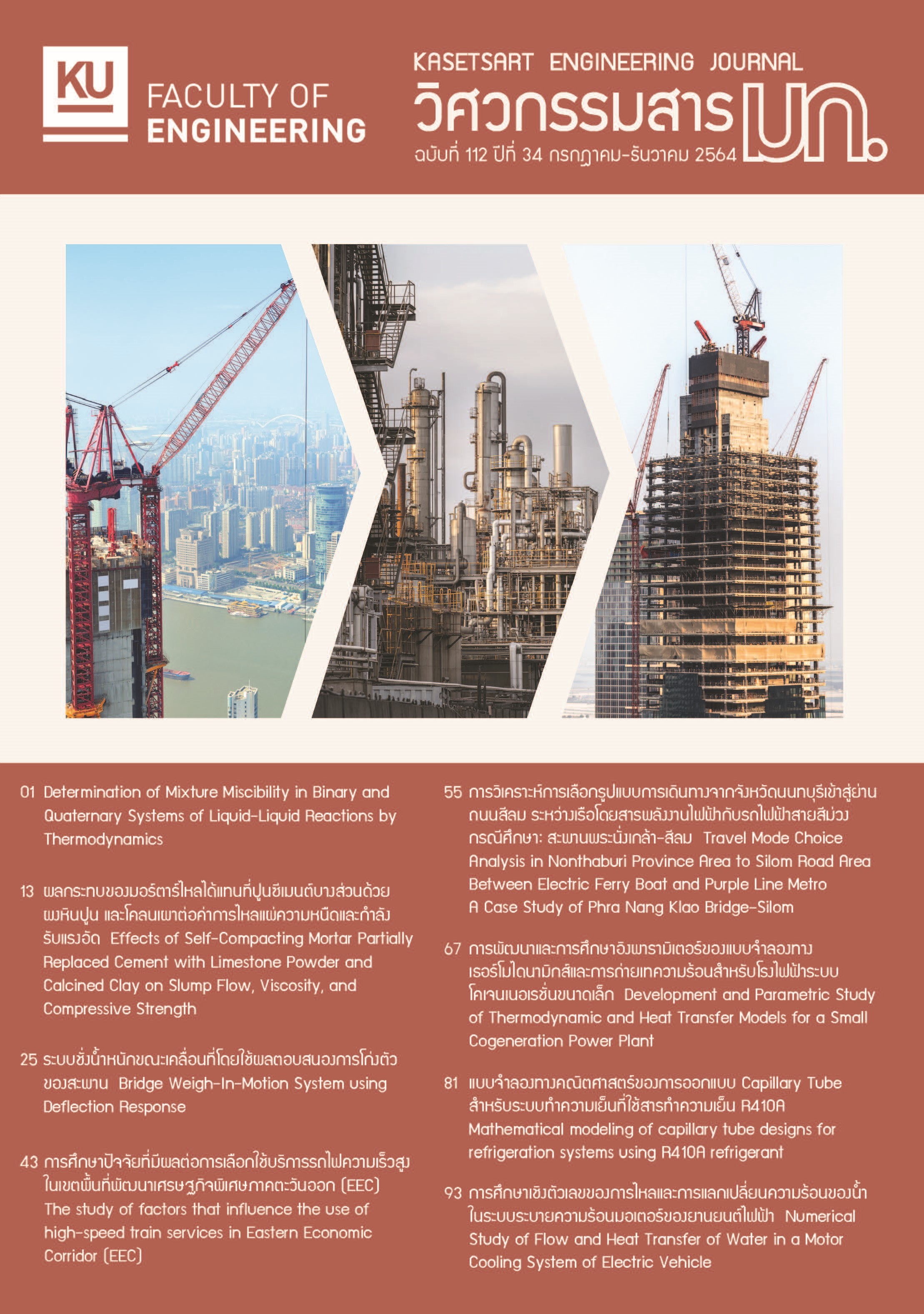Effects of Self-Compacting Mortar Partially Replaced Cement with Limestone Powder and Calcined Clay on Slump Flow, Viscosity, and Compressive Strength
Keywords:
Slump flow, viscosity, self-compacting mortar, limestone powder, calcined clayAbstract
This paper presents the effects of partial cement replacement by limestone and calcined clay for producing self-compacting mortar by testing flowability and mechanical properties with slump flow viscosity and compressive strength in order to propose an alternative which is eco-friendly material in construction industry. Amount of cement replacement by calcined clay were 15% and 25%, amount of limestone replacement was 15%. The results showed that the tested viscosity increased when replacing cement by calcined clay of 15% so that it necessary to use higher superplasticizer approximately 2–2.5 times for achieving the suitable slump flow. And it needed superplasticizer of 5–6 times when increasing limestone powder of 15%. Water to binder ratio (W/B) of 40% was suitable because the viscosity of mortar slightly changed with the increase of funnel time not over 3 s after 20 mins after mixing and the initial funnel time was 4–6 s. Replacement amount by calcined clay of 15% resulted in the increased of compressive strength of approximately 20–38% at 28 days with the compressive strength of approximately 700–830 ksc. Moreover, when the replacement ratio was 25% with limestone of 15%, it was found that the compressive strength decreased approximately 15–20% which were 450–490 ksc. Calcined clay can be used to replace cement for producing self-compacting mortar, the mechanical properties was improved and flowability was the most improved with the W/B of 40%. Calcined clay was an alternative material for reducing the demand of cement use.
References
Meanyut B, Tangchirapat W and Jaturapitakkul C (2019). High-Strength Concrete Containing High Volume of Ground Bottom Ash. Journal of Thailand Concrete Association, 7 (2): 14-24. (In Thai)
Kaewmanee K, Tangtermsirikul S and Komsan M (2015). Basic Properties and Durability of Concrete with Fly Ash and CACO3 Powder. Journal of Thailand Concrete Association, 3(2): 8-16.
Makaratat N, Norrarat P, Jaturapitakkul C, and Songpiriyakij S (2019). Influence of High Volume Ternary Blend from Fly Ash and Ground Granulated Blast Furnace Slag on Concrete Properties. Journal of Thailand Concrete Association, 7(2): 1-13. (In Thai)
Srisen A, Tangchirapat W, and Jaturapitakkul C (2014). Properties of Concrete Using Fly Ash and Calcium Carbide Residue as a Cementitious Material. KMUTT Research and Development Journal, 37(2): 165-175. (In Thai)
Kawaguchi N, Kohno K, and Mita M (1996). Influences of Superplasiticizer, Mixing Time, Mixing Temperature and Cement Content on High-Volume Fly Ash Concrete. Materials Science Research International, 2(4): 242-247.
K Scrivener, F Martirena, S Bishnoi, and S Maity (2018). Calcined clay limestone cements (LC3). Cement and Concrete Research, 114: 49-56.
Y Dhandapani, and M Santhanam (2020). Investigation on the microstructure-related characteristics to elucidate performance of composite cement with limestone-calcined clay combination. Cement and Concrete Research, 129: 105959.
S Ferreiro, M M C Canut, J Lund, and D Herfort 2019. Influence of fineness of raw clay and calcination temperature on the performance of calcined clay-limestone blended cements. Applied Clay Science, 169: 81-90.
Y Dhandapani, T Sakthivel, M Santhanam, R Gettu, and R G Pillai (2018). Mechanical properties and durability performance of concretes with Limestone Calcined Clay Cement (LC3). Cement and Concrete Research, 107: 136-151.
C Rodriguez and J I Tobon (2020). Influence of calcined clay/limestone, sulfate and clinker proportions on cement performance. Construction and Building Materials, 251: 119050.
Z Shi et al. (2019). Sulfate resistance of calcined clay – Limestone – Portland cements. Cement and Concrete Research, 116: 238-251.
R G Pillai et al. (2019). Service life and life cycle assessment of reinforced concrete systems with limestone calcined clay cement (LC3). Cement and Concrete Research, 118: 111-119.
Okamura H, and Ouchi M (2003). Self-Compacting Concrete. Journal of Advanced Concrete Technology, 1(15): 5-15.
Japan Society of Civil Engineers (1999). Recommendation for Self-Compacting Concrete.
Attachaiyawuth A (2015). Simple Evaluation of Flowability of Self-Compacting Concrete by Mortar Test. TCA E-Magazine. (In Thai)
Ouchi M, Edamatsu Y, Ozawa K, and Okamura H (1999). A Simple Evaluation Method for Intraction between Coarse Aggregate and Mortar's Particles in Self-Compacting Concrete. Transaction of The Japan Concrete Institute, 21: 1-6.
American Society for Testing and Materials (2017). ASTM C 494: Standard Specification for Chemical Admixtures for Concrete. Philadelphia, ASTM.
American Society for Testing and Materials (2020). ASTM C 109: Standard Test Method for Compressive Strength of Hydraulic Cement Mortars (Using 2-in. or [50-mm] Cube Specimens. Philadelphia, ASTM.
Rath S, Ouchi M, Puthipad N, and Attachaiyawuth A (2017). Improving the Stability of Entrained Air in Self-compacting Concrete by Optimizing the Mix Viscosity and Air Entraining Agent Dosage. Construction and Building Material, 148: 531-537.
Downloads
Published
Issue
Section
License

This work is licensed under a Creative Commons Attribution-NonCommercial-NoDerivatives 4.0 International License.


